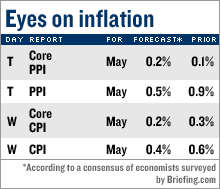Getting the price(s) right
With all eyes on inflation, there's a debate brewing about the best way to measure price pressures in the world's biggest economy.
NEW YORK (CNNMoney.com) - With markets around the world on inflation watch, the number that most matters to Ben Bernanke & Co. is one investors and economists won't get to see - until after the next Fed meeting. That 's because the number the Federal Reserve may rely on most when it comes to inflation is in a report on personal income and spending - a number that will be available to the central bank's policy-makers when they meet later this month but not to the public until June 30, the day after the Fed's rate decision is announced.
Whether the central bank raises rates again has consumed investors in recent weeks, and fears the Fed may raise rates too high, choking off economic growth, sent stocks tumbling worldwide last week. Thus, Tuesday's Producer Price Index, measuring wholesale prices, and the Consumer Price Index, the government's main inflation gauge, will get a great deal of attention this week. But several economists say the inflation reading from the personal income and spending report is a more nimble and accurate reading of inflation. The Fed generally gets government economic reports about a day ahead of their release to the public, so it's likely policy-makers will see the inflation reading in the income and spending report, which is due June 30, on June 29. Many experts say the so-called core PCE price reading in the report, stripping out food and energy, is most important to the Fed. In April, the core PCE rose at a 2.1 percent annual rate, up from the 2.0 percent rise in March, and coming in just above the Fed's presumed target of a 1 to 2 percent rise in core inflation. But the core PCE was still below the 2.3 percent annual increase in the core CPI over the same 12 months. Faster off the mark
Bernard Baumohl, executive director of the Economic Outlook Group in Princeton, N.J., is one of many economists who say the PCE is a more important measure of inflationary pressures than the PPI or CPI. "The Fed looks very closely at the PCE and core PCE, and the financial markets know the Fed is closely looking at those," he said. "They're more flexible, they adjust more easily to changes in consumption and they're more comprehensive." But the PPI and CPI are still very important for a number of reasons. First of all, they are important building blocks to the PCE readings. The Labor Department, which compiles the two price indexes due this week, measures a broad range of goods and services to come up with its numbers. But its weighting of those numbers is fixed for years at a time. The Commence Department, which compiles the income and spending report that includes the PCE, measures how much is actually being spent on different types of goods each month, and then adjusts that for inflation using the Labor Department's inflation numbers. So the PCE is essentially recalibrated to adjust for real-world consumption every month. The CPI is also important because it is the basis for a number of government benefits, including Social Security benefit increases, indexing of tax brackets and cost of living adjustments in some labor contracts. But there have been arguments that it overstates inflation. A debate over accuracy
But Dean Baker, co-director at the Center for Economic and Policy Research and author of the book "Getting Prices Right," which looked at the debate over CPI, said the CPI can also understate some important price measures. For example the CPI measures the prices of health care, but not health insurance premiums or copayments required of those covered by insurance, which is the primarily cost of health care for many Americans. It also looks at the price of rent and the equivalent cost of renting owner-occupied homes, rather than looking at the cost of actually buying a home. So rising mortgage rates or property taxes are not necessarily captured by the report. Both PCE and CPI try to measure the broad range of prices across the economy. But inflation pressures can also be discerned by looking at some other government readings, including the Employer Cost Index or the Labor Department's Import and Export Prices. Friday the Labor Department's Import Price Index showed a import prices increasing 1.6 percent in May. But Baumohl argues that excluding oil prices, import prices have essentially been flat since October, even with a jump in the May reading. "Foreign companies have chosen to absorb currency loss rather than raise prices and risk losing market share in the United States," he said. Baumohl is one of the economists who think that the Fed will raise rates at the June meeting, no matter what inflation readings come in at between now and then. "Even if inflation did fall back into the comfort zone, there have been enough questions raised whether [new Fed Chairman Ben]Bernanke is an effective inflation fighter that he's under tremendous pressure to raise to 5.25," said Baumohl. But he thinks despite recent concerns, inflation pressures are waning and the Fed may be able to stop after June. One thing he points to is the spread between the traditional benchmark 10-year Treasurys, and the inflation protected TIPS notes. Even with the 10-year falling to about 5 percent in recent weeks, the TIPS have fallen even faster, taking the spread to about 2.5 percent, compared to 2.72 a month ago. "The fact they've been dropping is showing that bond traders are less concerned than they were two or four weeks ago," he said. "All the forces that have kept inflation contained - productivity, globalization - are still in effect." Related: Inflation's fear factor
Special report: Eyes on the Fed |
| ||||||||||||||||||


